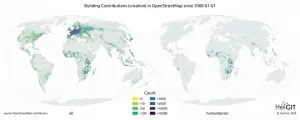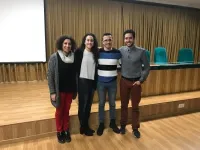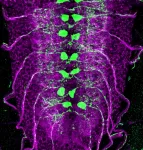(Press-News.org) UNIVERSITY PARK, Pa. -- In a new study, Penn State researchers demonstrated that facilitating researcher-policymaker interactions in rapid response processes can influence both how legislators think about policy issues and how they draft legislation.
Penn State professors Max Crowley, associate professor of human development and family studies, and public policy, and Taylor Scott, assistant research professor in the Edna Bennett Pierce Prevention Research Center, co-direct the Research-to-Policy Collaboration, which connects members of Congress with researchers who synthesize evidence about family and child policy in a timely and digestible manner.
The Research-to-Policy Collaboration has the potential to improve the quality of information available to Congress, increase the impact of relevant research, and create more common ground among American lawmakers at a polarized point in our history, said the researchers.
"We believe that lawmakers can make better use of research throughout the planning, decision making, allocation of resources, and implementation of policies," said Crowley. "The goal of our work is to build a bridge between the research community and policy community. This study examined whether Congress would put research to better use if we facilitated researchers' rapid responses to their specific questions."
The research team wants to improve how lawmakers use scientific evidence, but the researchers do not lobby Congress. In lobbying, people try to influence how lawmakers act on an issue. The Research-to-Policy Collaboration provides evidence -- not opinions -- on specific legislation or federal programs.
"Issues relating to children are important to everyone, no matter where they fall on the political spectrum," Scott said. "There are a lot of opportunities for non-partisan or bipartisan conversations about children and family issues, which is not always the case for a lot of other important topics."
The researchers hope to change the culture of how Congress uses research. Like many other people, lawmakers at times cherry-pick statistics or cite single research studies that reinforce their entrenched positions on issues, said the researchers. People across the political spectrum are prone to using research in this tactical manner when addressing polarizing topics like climate change, healthcare or taxes.
In contrast, researchers in the Research-to-Policy Collaboration seek to increase the use of research evidence when policies are conceptualized or framed. For example, when drafting new laws, lawmakers could consider funding programs or policies that have been shown to be effective by research, said the researchers. This model encourages the use of research evidence as a tool for informed decision making and does not support tactical uses of research for bolstering a political position.
The difference between lobbying and collaboration is not lost on those who participated in the study, explained the researchers. A counsel to a senator who worked with the researchers said, "It was not lobbyists asking us for something but really us asking what we needed and them providing it back, so it was a really helpful relationship."
This study was the Research-to-Policy Collaboration model's first experiment involving Congress, and the results were clear, the researchers reported. Participating legislative offices sponsored more than 20% more bills containing research language compared to legislative offices in the control group of the study.
Furthermore, participating members of Congress did not become more likely to single out select statistics or cite individual research studies to defend an entrenched position, according to the study. The members also showed a modest increase in their belief that research evidence is valuable for understanding how to think about problems when developing legislation.
Crowley and Scott are optimistic both because of the potential in the Research-to-Policy Collaboration model and because they believe that members of Congress want to use the best available information to make the most informed decisions possible.
"In my experience, people want to use science, no matter their party affiliation," Crowley stated. "The use of science is not partisan, per se."
Crowley and Scott recognize that this approach will not solve partisan issues in lawmaking bodies, they said, but they hope that promoting the use of scientific evidence can establish a common language for debate.
"Recently, our society has struggled to find common ground about what is fact and what is truth," said Scott. "If we can enable people of different parties to understand scientific evidence, then we can start the process of finding common ground.
"In our work, we have seen lawmakers take scientific evidence that we provided across the aisle to their colleagues," Scott continued. "We also have seen those recipients embrace the evidence, and this has served as the starting point for meaningful conversation."
INFORMATION:
The article, "Lawmaker's use of scientific evidence can be improved," will be published in Proceedings of the National Academy of Sciences.
Other authors include Lawrie Green, Azaliah Israel, Lauren Supplee, Elizabeth Jordan, Kathryn Oliver, Shannon Guillot-Wright, Brittany Gay, Rachel Storace, Naomi Torres-Mackie, Yolanda Murphy, Sandra Donnay, Jenna Reardanz, Rebecca Smith, Kristina McGuire, Elizabeth Baker, Ana Antonopoulos, Mary McCauley and Cagla Giray.
This research was funded by the Eunice Kennedy Shriver National Institute of Child Health and Human Development and the William T. Grant Foundation.
Scientists from the Stanley Manne Children's Research Institute at Ann & Robert H. Lurie Children's Hospital of Chicago demonstrated that a nanotherapy reduces intestinal inflammation and shrinks lesions in a rodent model of severe Crohn's disease. This approach could become an alternative to biologic antibody therapies that carry many side effects, including increased risk of certain cancers. It might also prevent the need for surgery in the future. Findings were published in the journal Advanced Therapeutics.
Crohn's disease is an inflammatory bowel disease characterized by chronic inflammation of the digestive tract, most often in the small intestine. ...
In response to the increase in opioid overdose deaths in the United States, many states have implemented supply-controlling and harm-reduction policy measures aimed at reducing those deaths. But a recent study from Indiana University found the policies may have had the unintended consequence of motivating those with opioid use disorders to switch to alternative illicit substances, leading to higher overdose mortality.
"Literature from public health to social sciences has presented mixed and contradictory findings on the impact of opioid policies on various opioid ...
INFORMS Journal on Applied Analytics Key Takeaways:
Although waiting times in walk-up clinics are shorter, people preferred the convenience of drive-through clinics.
People believe drive-through clinics are safer, more convenient and less contagious.
You can vaccinate a large number of people without a lot of waiting and confusion using a drive-through clinic.
CATONSVILLE, MD, February 17, 2021 - Policymakers at all levels of government are racing to vaccinate hundreds of millions of people to save lives and blunt the deadly COVID-19 pandemic. New research published ...
Researchers have developed a new tool for addressing disseminated intravascular coagulation (DIC) - a blood disorder that proves fatal in many patients. The technology has not yet entered clinical trials, but in vivo studies using rat models and in vitro models using blood from DIC patients highlight the tech's potential.
"DIC basically causes too much clotting and too much bleeding at the same time," says Ashley Brown, corresponding author of a paper on the work. "Small blood clots can form throughout the circulatory system, often causing organ damage. And because this taxes the body's supply of clotting factors, patients also experience excess bleeding. Depending on ...
In recent years, free digital world maps like OpenStreetMap (OSM) have become a vital instrument to support humanitarian missions over the entire world. In disaster management as well as the implementation of the United Nations Sustainability Development Goals (SDGs), geodata compiled by the volunteer mapper community open up new possibilities to coordinate aid interventions and carry out sustainability projects. The mapping data are collected either locally using a smartphone and GPS device or on the basis of satellite images. An international team of researchers led by geoinformation ...
The 10 year anniversary of the Fukushima Daiichi nuclear accident occurs in March. Work just published in the Journal 'Science of the Total Environment' documents new, large (> 300 micrometers), highly radioactive particles that were released from one of the damaged Fukushima reactors.
Particles containing radioactive cesium (134+137Cs) were released from the damaged reactors at the Fukushima Daiichi Nuclear Power Plant (FDNPP) during the 2011 nuclear disaster. Small (micrometer-sized) particles (known as CsMPs) were widely distributed, reaching as far as Tokyo. CsMPs have been the subject of many studies in recent years. However, it recently became apparent that larger (>300 micrometers) Cs-containing particles, with much higher levels of activity (~ 105 Bq), were also ...
The brain's neural activity is irregular, changing from one moment to the next. To date, this apparent "noise" has been thought to be due to random natural variations or measurement error. However, researchers at the Max Planck Institute for Human Development have shown that this neural variability may provide a unique window into brain function. In a new Perspective article out now in the journal Neuron, the authors argue that researchers need to focus more on neural variability to fully understand how behavior emerges from the brain.
When neuroscientists investigate the brain, its activity seems to vary all the time. Sometimes activity is higher or lower, rhythmic or irregular. Whereas averaging brain activity ...
The researchers analysed how Spanish children and adolescents get to school, based on studies examining the commuting patterns of 36,781 individuals over a 7-year period (2010-2017)
Researchers from the University of Granada (UGR) have conducted the most comprehensive study to date on how Spanish children and young people get to school each day, to determine the active commuting rate.
The results showed that, between 2010 and 2017, in the region of 60% of Spanish children and adolescents actively commuted to school, with no significant variations being observed during this period.
The study, which was recently ...
Our brains are complicated webs of billions of neurons, constantly transmitting information across synapses, and this communication underlies our every thought and movement.
But what happens to the circuit when a neuron dies? Can other neurons around it pick up the slack to maintain the same level of function?
Indeed they can, but not all neurons have this capacity, according to new research from the University of Chicago. By studying several neuron pairs that innervate distinct muscles in a fruit fly model, researchers found that some neurons compensate for ...
Scientists have used cutting-edge research in quantum computation and quantum technology to pioneer a radical new approach to determining how our Universe works at its most fundamental level.
An international team of experts, led by the University of Nottingham, have demonstrated that only quantum and not classical gravity could be used to create a certain informatic ingredient that is needed for quantum computation. Their research "Non-Gaussianity as a signature of a quantum theory of gravity" has been published today in PRX Quantum.
Dr Richard Howl led the research during his time at the University of Nottingham's School of Mathematics, he said: "For ...




